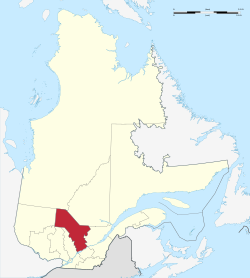Mauricie | |
|---|---|
 | |
| Coordinates: 47°00′N 73°00′W / 47.000°N 73.000°W | |
| Country | |
| Province | |
| Regional County Municipalities (RCM) and Equivalent Territories (ET) | 3 RCM, 3 ET |
| Government | |
| • Table des élus de la Mauricie (Regional conference of elected officers) | Gérard Bruneau (President) |
| Area | |
| • Land | 35,860.05 km2 (13,845.64 sq mi) |
| Population | |
| • Total | 266,112 |
| • Density | 7.4/km2 (19/sq mi) |
| • Change 2011-2016 | |
| Time zone | UTC-5 (EST) |
| • Summer (DST) | UTC-4 (EDT) |
| Postal code | |
| Area code | 819, 873 |
| Website | www |
Mauricie (French pronunciation: [mɔʁisi]) is a traditional and current administrative region of Quebec. La Mauricie National Park is contained within the region, making tourism in Mauricie popular. The region has a land area of 35,860.05 km2 (13,845.64 sq mi) and a population of 266,112 residents as of the 2016 Census.[1] Its largest cities are Trois-Rivières and Shawinigan.
The word Mauricie was coined by local priest and historian Albert Tessier and is based on the Saint-Maurice river which runs through the region on a North-South axis.
Mauricie administrative region was created on August 20, 1997 from the split of Mauricie–Bois-Francs administrative region into Mauricie and Centre-du-Québec.[2] However, the concept of Mauricie as a traditional region long predates this.
Administrative divisions
[edit]Regional county municipalities
[edit]- Les Chenaux Regional County Municipality
- Maskinongé Regional County Municipality
- Mékinac Regional County Municipality
Equivalent territories
[edit]- Agglomeration of La Tuque
- Shawinigan
- Trois-Rivières
Independent municipalities
[edit]Major communities
[edit]School districts
[edit]10 Francophones:
- Centre de services scolaire du Chemin-du-Roy:
- Trois Rivières (3 districts)
- Maskinongé and
- Francheville.
- Centre de services scolaire de l'Énergie:
- Shawinigan (2 districts),
- La Tuque,
- Mékinac and
- Maskinongé.
Part of Anglophone:
Notable people
[edit]- Moïsette Olier (1885–1972), writer
- Jacques Plante (1929–1986), ice hockey goaltender
References
[edit]- ^ a b c "Census Profile, 2016 Census Mauricie [Economic region], Quebec". Statistics Canada. 8 February 2017. Retrieved November 22, 2019.
- ^ "Modifications aux municipalités du Québec" (PDF). Bureau de la statistique du Québec. August 1997. ISSN 0843-8250. Retrieved 2012-05-20.[permanent dead link]
- ^ "Mauricie (Code 2470) Census Profile". 2011 census. Government of Canada - Statistics Canada.
External links
[edit]- Portail de la Mauricie Official website
- Tourisme Mauricie Regional tourist office
- CRÉ
Well, that’s interesting to know that Psilotum nudum are known as whisk ferns. Psilotum nudum is the commoner species of the two. While the P. flaccidum is a rare species and is found in the tropical islands. Both the species are usually epiphytic in habit and grow upon tree ferns. These species may also be terrestrial and grow in humus or in the crevices of the rocks.
View the detailed Guide of Psilotum nudum: Detailed Study Of Psilotum Nudum (Whisk Fern), Classification, Anatomy, Reproduction